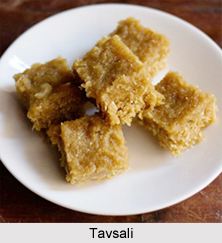 Tavsali is a sweet recipe from Goa which is made with cucumber, jaggery, coconut and semolina as the main ingredients. It is basically a "Cucumber Cake" called "Tavsali". The Tavsali word is derived from the word "Tavshem" which is a Konkani term for cucumber. The cake has a dominant taste of cucumber which sort of overpowers everything. It"s not overtly sweet but has a light sweetness. In this recipe the cake is steamed instead of baking it. The texture is light, moist and soft as most steamed cakes have.
Tavsali is a sweet recipe from Goa which is made with cucumber, jaggery, coconut and semolina as the main ingredients. It is basically a "Cucumber Cake" called "Tavsali". The Tavsali word is derived from the word "Tavshem" which is a Konkani term for cucumber. The cake has a dominant taste of cucumber which sort of overpowers everything. It"s not overtly sweet but has a light sweetness. In this recipe the cake is steamed instead of baking it. The texture is light, moist and soft as most steamed cakes have.
Health Benefits of Tavsali
Tavsali is very nutritious, light and a healthy dessert for kids as well as adults. Cucumber contains Vitamin A, B and C which boost the immunity. It provides minerals like potassium and magnesium to the body.
Ingredients for Tavsali:
•Semolina/Rava/Sooji - 1.5 cups
•Jaggery - 1.5 cups
•Green Cardamoms - 4 to 5
•Fresh Coconut - 3/4 cup, grated
•Cucumber - 2 cups, grated
•Cumin Powder - 1/4 tsp
•Cashews - 2 to 3 tbsp, chopped (optional)
•Coconut Oil or Ghee - 1/2 tsp, for greasing the pan
Method:
1. Roast the Rava/sooji/semolina till fragrant comes out. Keep aside.
2. Take the cardamoms in a mortar-pestle and powder them. Discard the peels and keep the cardamom powder aside
3. In a mixing bowl, take the roasted semolina.
4. Mix in the grated cucumber along with its juice, grated coconut,
chopped cashews and add the powdered jaggery.
5. Lastly, add the cardamom powder and cumin powder.
6. Mix the batter very well without any lumps.
7. Heat about 3 cups of water in a steamer or a pressure cooker.
8. Grease the pan with coconut oil or ghee.
9. Pour the batter in the pan.
10. Place the pan in the steamer or pressure cooker.
11. Cover the cooker with its lid. If using pressure cooker, then remove the vent weight (whistle) from the lid and then tightly cover the cooker with its lid.
12. Steam for 30 to 40 minutes until a knife inserted comes out clean.
13. When the cucumber cake become warm or is cooled completely, then slice and serve them.
Related Articles
Food in Ancient India
Food in Vedic Period
Recipes in Vedic Period
Goa Cuisine
Indian Desserts
Indian Sweets
Indian Sweet Recipe
Types of Indian Sweets
Sweets of Western India
Traditional Indian Sweets




















